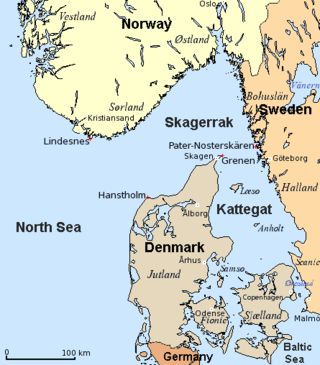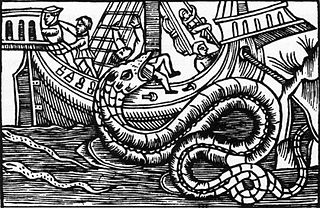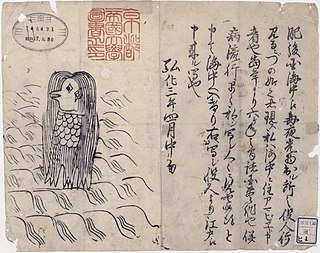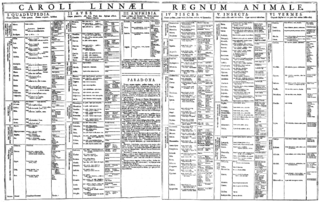
The sea monk (also monk-fish or monkfish) was a sea creature found off the eastern coast of the Danish island of Zealand in 1546. It was described as a "fish" that outwardly resembled a human monk in his habit.

The sea monk (also monk-fish or monkfish) was a sea creature found off the eastern coast of the Danish island of Zealand in 1546. It was described as a "fish" that outwardly resembled a human monk in his habit.
The creature was called "monk fish" (Latin : piscis monachus ) by Belon (1553), and piscis monachi habitu ("fish [wearing] the habit of a monk") by Rondelet (1554). [1]
The name "sea monk" ( monachus maris ) was applied to it by Gesner (1558), [2] and Joannes Sluperius (1572; Latin : monachus marinus ; French : moyne marin ) as well. [1] [3]
The alleged sea monk was captured at sea between Denmark's Zealand and Sweden, in the strait Øresund, probably in 1546. [4] Christian III of Denmark sent an illustration of it to Charles V, Holy Roman Emperor. [1] The creature is recorded in Vedel's Den danske Krønicke (1575) as measuring 4 ells long (15 ft; 4.6 m). [5] It was either caught in a herring net, or stranded, depending on the source. [6]

The capture of the sea monk is dated to either 1546 or 1549 in 16th-century literature, or to both dates, in the case of Lycosthenes (1557), who states both captures occurred near Copenhagen, Denmark. [8] [5] There is also a German woodcut by Stefan Hamer possibly dating to 1546, illustrating the sea-monk caught in Copenhagen in 1546. [9]
The sea monk was listed in several illustrated natural history books published in the mid-16th century, such as Pierre Belon (1553), Guillaume Rondelet (1554), and Conrad Gesner (1558). [1] It was described as a "fish" that looked superficially like a monk.
Belon (1553) gave a briefer notice on piscis monachus (monk-fish) in his Latin volume, a more expanded account appearing later in his French version of 1555. [10]
Rondelet (1554) called it "the fish with the habit of a monk (piscis monachi habitu), [1] and classed it as a merman (homo maris). [11] But he did not think the pictorial representations he obtained could be taken at face value, and suspected they were embellished "by the painter to make the thing seem more marvelous". [11] What prompted his suspicions of artistic license seems to be his discovery of other portrayals of the monkfish, quite different from his own, obtained by his rival and friend Gesner and others in Rome. [12]
Rondelet stated that a drawing of it from life (or corpse) was made by an artist in the presence of a certain gentleman, who gave a copy to Charles V, and another copy to Marguerite, Queen of Navarre, the latter of which was provided to Rondelet. [13] [14] [15] The picture being the gift of Marguerite, a great patron of the sciences, meant it was not something to be readily dismissed, but rather authenticated, by Marguerite, treated as an authority on par with Pliny. [16]
Rondelet's information was imperfect in other ways: he stated the creature had been taken in "Norway [sic.] at Diezum near the town called Denelopoch", but this was a garbling of Die Sund ("the Sound" of Øresund) off of Ellenbogen (Malmö, Sweden). The information was conveyed through some intermediary German source. [17] [14] [14]
Belon (1555) in his French edition about the monk-fish also classed the monk-fish as a merman (French : homme marin), and garnished his commentary with mention of merfolk from ancient writings, specifically sirens, tritons, naiads, and nereids. [18] [19] Belon, according to Steenstrup's assessment, had faith in the existence of this sea monk without ever having seen one. [20] Belon attributed these curiosities to "playfulness of Nature". [21]
The fourth volume of Conrad Gesner's famous Historia Animalium described it, [22] and although much of Gesner's piece was derivative or even copied wholesale from his predecessors, Belon and Rondelet, he appended a collolarium section containing his own findings and observations. As to the creature that measured 4 cubits, Gesner added that it had a black face like an Ethiopian, according to a German rhyme. [21] [23] Gesner here quoted Albertus Magnus's account of the monachus maris. [2] He also mentioned a similar monster found in the Firth of Forth, citing Scottish historian Hector Boethius (Hector Boece). [24] Gesner had two other sources to draw from, namely Georg Fabricius and Hector Mythobius. [25]
The aforementioned Lycosthenes in Prodigiorum ac Ostentorum Chronicon [Of Portents and Shown Times] (1557) described the 1546 sea monk as having a black head, and gave an illustration of it as such. [26]
The sea monk was subsequently popularised in Guillaume du Bartas's epic poem La Sepmaine; ou, Creation du monde, where the poet speaks of correspondences between land and sea, mentioning both the "mytred Bishop" and the "cowled Fryer":
"Seas have (as well as skies) Sun, Moon, and Stars;
(As well as ayre) Swallows, and Rooks, and Stares;
(As well as earth) Vines, Roses, Nettles, Millions,
Pinks, Gilliflowers, Mushrooms, and many millions
of other Plants lants (more rare and strange than these)
As very fishes living in the Seas.
And also Rams, Calfs, Horses, Hares, and Hogs,
Wolves, Lions, Urchins, Elephants and Dogs,
Yea, Men and Mayds; and (which I more admire)
The mytred Bishop and the cowled Fryer;
Whereof, examples, (but a few years since)
Were shew'n the Norways, and Polonian Prince."
In the early 1850s, Danish zoologist Japetus Steenstrup suggested that the sea-monk was a giant squid, [27] [28] [14] a theory more recently popularised by writer Richard Ellis. [29] Cryptozoologist Bernard Heuvelmans believed the report was based on the discovery of an errant walrus. [30]
More recently, it has been suggested that it was an angelshark, Squatina squatina, which is commonly called "monkfish" in English or munk in Norwegian and Danish. [31] Other suspected identities of the sea monk include the grey seal, the hooded seal, the monk seal, [32] or a hoax such as a Jenny Haniver. [33]

The Kattegat is a 30,000 km2 (12,000 sq mi) sea area bounded by the Jutlandic peninsula in the west, the Danish Straits islands of Denmark and the Baltic Sea to the south and the provinces of Bohuslän, Västergötland, Halland and Skåne in Sweden in the east. The Baltic Sea drains into the Kattegat through the Danish Straits. The sea area is a continuation of the Skagerrak and may be seen as a bay of the North Sea and North Atlantic Ocean, but in traditional Scandinavian usage, this is not the case.

A sea serpent or sea dragon is a type of dragon sea monster described in various mythologies, most notably Mesopotamian (Tiamat), Judaeo-Christian (Leviathan), Greek, and Norse (Jörmungandr).

In folklore, a mermaid is an aquatic creature with the head and upper body of a female human and the tail of a fish. Mermaids appear in the folklore of many cultures worldwide, including Europe, Asia, and Africa.

Pierre Belon (1517–1564) was a French traveller, naturalist, writer and diplomat. Like many others of the Renaissance period, he studied and wrote on a range of topics including ichthyology, ornithology, botany, comparative anatomy, architecture and Egyptology. He is sometimes known as Pierre Belon du Mans, or, in the Latin in which his works appeared, as Petrus Bellonius Cenomanus. The Russian physiologist Ivan Pavlov called him the "prophet of comparative anatomy".

The Fiji mermaid was an object composed of the torso and head of a juvenile monkey sewn to the back half of a fish. It was a common feature of sideshows where it was presented as the mummified body of a creature that was supposedly half mammal and half fish, a version of a mermaid. The original had fish scales with animal hair superimposed on its body and pendulous breasts on its chest. The mouth was wide open with its teeth bared. The right hand was against the right cheek, and the left tucked under its lower left jaw. This mermaid was supposedly caught near the Fiji Islands in the South Pacific. Several replicas and variations have also been made and exhibited under similar names and pretexts. P. T. Barnum exhibited the original in Barnum's American Museum in New York in 1842, but it then disappeared—likely destroyed in one of the many fires that destroyed parts of Barnum's collections.

A merman, the male counterpart of the mythical female mermaid, is a legendary creature which is human from the waist up and fish-like from the waist down, but may assume normal human shape. Sometimes mermen are described as hideous and other times as handsome.

The Hawaiian monk seal is an endangered species of earless seal in the family Phocidae that is endemic to the Hawaiian Islands.

Monk seals are earless seals of the tribe Monachini. They are the only earless seals found in tropical climates. The two genera of monk seals, Monachus and Neomonachus, comprise three species: the Mediterranean monk seal, Monachus monachus; the Hawaiian monk seal, Neomonachus schauinslandi; and the Caribbean monk seal, Neomonachus tropicalis, which became extinct in the 20th century. The two surviving species are now rare and in imminent danger of extinction. All three monk seal species were classified in genus Monachus until 2014, when the Caribbean and Hawaiian species were placed into a new genus, Neomonachus.

The Mediterranean monk seal is a monk seal belonging to the family Phocidae. As of 2015, it is estimated that fewer than 700 individuals survive in three or four isolated subpopulations in the Mediterranean, (especially) in the Aegean Sea, the archipelago of Madeira and the Cabo Blanco area in the northeastern Atlantic Ocean. It is believed to be the world's rarest pinniped species. This is the only species in the genus Monachus.

Guillaume Rondelet, also known as Rondeletus/Rondeletius, was Regius professor of medicine at the University of Montpellier in southern France and Chancellor of the University between 1556 and his death in 1566. He achieved renown as an anatomist and a naturalist with a particular interest in botany and ichthyology. His major work was a lengthy treatise on marine animals, which took two years to write and became a standard reference work for about a century afterwards, but his lasting impact lay in his education of a roster of star pupils who became leading figures in the world of late-16th century science.

In late Classical Greek art, ichthyocentaurs were centaurine sea beings with the upper body of a human, the lower anterior half and fore-legs of a horse, and the tailed half of a fish. The earliest example dates to the 2nd century B. C., among the friezes in the Pergamon Altar. There are further examples of Aphros and/or Bythos, the personifications of foam and abyss, respectively, depicted as ichthyocentaurs in mosaics and sculptures.
Historia animalium, published in Zurich in 1551–1558 and 1587, is an encyclopedic "inventory of renaissance zoology" by Conrad Gessner (1516–1565). Gessner was a medical doctor and professor at the Carolinum in Zürich, the precursor of the University of Zurich. The Historia animalium, after Aristotle's work of the same name, is the first modern zoological work that attempts to describe all the animals known, and the first bibliography of natural history writings. The five volumes of natural history of animals cover more than 4500 pages.

The seven-arm octopus, also known as the blob octopus or sometimes called septopus, is one of the two largest known species of octopus; the largest specimen ever discovered had an estimated total length of 3.5 m (11 ft) and mass of 75 kg (165 lb). The only other similarly large extant species is the giant Pacific octopus, Enteroctopus dofleini.

The kraken is a legendary sea monster of enormous size, etymologically akin to a squid or octopus, said to appear in the sea between Norway and Iceland. It is believed the legend of the Kraken may have originated from sightings of giant squid, which may grow to 12–15 m in length.

Amabie (アマビエ) is a legendary Japanese mermaid or merman with a bird beak-like mouth and three legs or tail-fins, who allegedly emerges from the sea, prophesies either an abundant harvest or an epidemic, and instructed people to make copies of its likeness to defend against illness.

Animalia Paradoxa are the mythical, magical or otherwise suspect animals mentioned in the first five editions of Carl Linnaeus's seminal work Systema Naturae under the header "Paradoxa". It lists fantastic creatures found in medieval bestiaries and some animals reported by explorers from abroad and explains why they are excluded from Systema Naturae. According to Swedish historian Gunnar Broberg, it was to offer a natural explanation and demystify the world of superstition. Paradoxa was dropped from Linnaeus' classification system as of the 6th edition (1748).

The Shenandoah is a three-masted schooner with a steel hull, built in New York in 1902 as a private yacht for the American financier Gibson Fahnestock. She has had a series of private owners since, and is available today for charter.
"The Soul Cages" is a fairy tale invented by Thomas Keightley, originally presented as a genuine Irish folktale in T. Crofton Croker's Fairy Legends and Traditions of the South of Ireland (1825–28). It features a male merrow (merman) inviting a local fisherman to his undersea home. The "soul cages" in the title refer to a collection of human souls that the merman kept in his home.
{{cite journal}}: CS1 maint: multiple names: authors list (link)